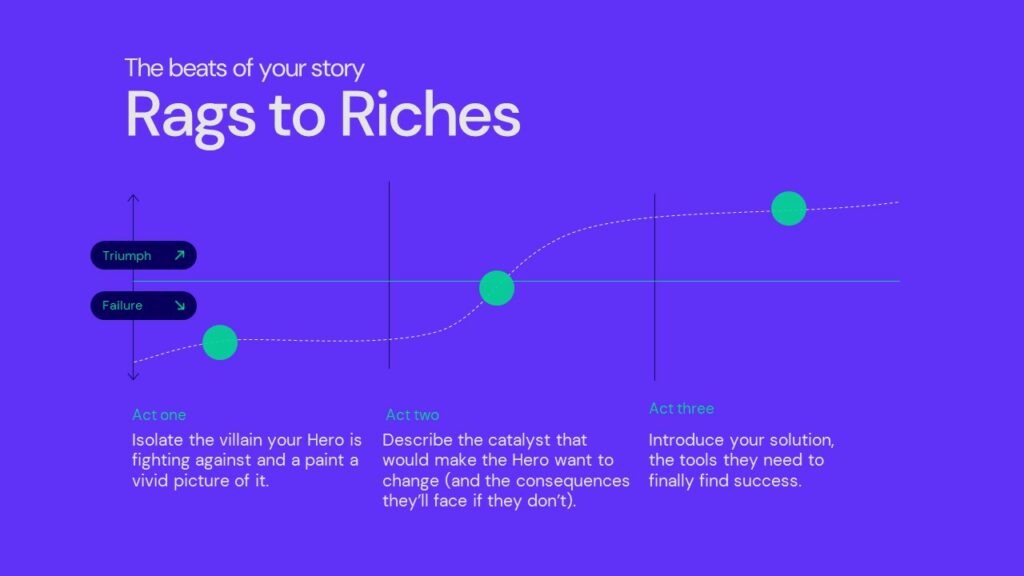Presentation Story Structures: Rags to Riches
Who doesn’t love a good underdog story? The Hero rises from nothing, battling hard against adversity until finally, they strike gold. This tried-and-true narrative arc is more than just a captivating storyline. Rags to Riches is one of six secret sauces you can use to transform your presentations from bland to brilliant.
Let’s talk arcs
Before we dive into the detail of Rags to Riches, let’s make a quick pit stop at the meeting point of all six narrative arcs. Put simply, a narrative arc is the overarching shape of a story. It’s the thread that weaves together the individual story strands, establishing the pattern the beginning, middle and end should take. It gives structure to the plot and predictable purpose to the characters.
At Future Present, we use six narrative arcs in our presentation storytelling. We didn’t come up with them – they’re just the ones we like best from all the separate arcs every creative writer has come up with.
Anyway, in no particular order, they are Rags to Riches, the Hero’s Journey, Overcoming the Monster, In Medias Res, Man in a Hole and Sparklines. They’re all variations on the classic three-act structure, and they all serve their own specific purposes.
This post is going to focus on Rags to Riches, the Cinderella arc. Let’s look a little closer.
Using the Rags to Riches arc in presentations

Why should I bother shoehorning narrative arcs into a PowerPoint presentation at all? I hear you ask. Because narrative predictability, the familiarity of stories and recognisable characters are the WD-40 of information transfer. They smooth the way for an audience to gobble up and properly digest all those delicious facts and figures you’re trying so hard to convey.
The Rags to Riches arc is the perfect recipe for that kind of info dump. It brings together despair, hope, triumph and an aspirational thrill that keeps even the most reluctant audience hooked for good.
How do you inject your deck with Rags to Riches magic?
Stirring story and presentation into the same thought soup
So how do you go about Cinderella-ifying your decks? Let’s break it down.
Step one is creating a compelling cast of characters. There’s a simple trio we focus on for presentations, which stays the same regardless of the arc you choose to use. There’s a Hero, a Villain and a Guide. We go into detail around that here [link to You are NOT the hero of your presentations blog], but the TL;DR is this: you (your brand, your team, your product) are the Guide, your audience is the Hero, and the Villain is the challenge(s) you’re solving for your Hero.
Step two is setting the scene, which is where the arcs diverge. In the case of Rags to Riches, once you’ve got a definable Hero, you need to paint a picture of their humble beginnings. If we look at the arc shape plotted on a graph, you’ll see that the beginning of the story should be your Hero’s lowest point. If you’re solving a challenge the Hero is already facing, perhaps you open the presentation by describing the ramifications your Hero will face if they don’t nip it in the bud now.
Step three is figuring out how you, the Guide, are going to provide your Hero with the toolkit they need to escape this failure and rise triumphant. Figure that out and then spell it out, but keep your Hero the focus of every slide.
Round out the deck, as always, with a beefing up of your sparkling credentials, and there you go – there’s the Rags to Riches recipe.
Rags to Riches in action
This arc isn’t restricted to panto and nursery tales, it’s all over the place. In business (Nike went from humble beginnings distributing shoes from the boot of a car). In public figures (Oprah Winfrey came from poverty to become a global icon). And, of course, in media (Cinderella, the Pursuit of Happyness, Slumdog Millionaire, Harry Potter, etc etc etc).
It’s ubiquitous for a reason. Because it speaks to the basic human traits of greed, victory over villainy and the idea that good will out (if it’s canny enough, that is). A story that’s effectively familiar to all of us, which is a powerful tool for making your presentation content sticky.
It’s a balancing act
It’s all well and good to sit here and preach about the effectiveness of a rigid narrative arc structure for presentations. But the reality is that, whilst narrative arcs can be a powerful tool, they’re not a one-size-fits-all answer to the complex problem of properly putting together a pitch.
The Rags to Riches arc works best when your story has a strong transformative slant or a significant journey of growth. If your story is missing those ingredients, this might not be the arc for you. There are five others we rely on as starting points, but they might not work either.
When it comes to constructing compelling narratives, it’s crucial to maintain creative flexibility. We use these arcs as guides, not as rigid blueprints. Our aim is always to tell the most engaging, authentic story possible. That’s what’s going to resonate with your audience and support your key messages without feeling disingenuous.
It’s not just about upping the snap
- In a nutshell, storytelling in presentations isn’t just about adding drama or theatrics. It’s about providing a clear, relatable and, most importantly, memorable context for your content. It’s about making your audience care and leading them towards the outcomes you desire most.
With Rags to Riches, you get all that, plus the bonus of that timeless allure – the human fascination with transformation. So next time you’re creating a presentation, why not sprinkle a little Cinderella magic over your slides. Then you can just sit back and watch that engagement soar.
Or if you can’t be bothered with all that faff, why not just get us to do it for you? Get in touch now to chat about your next presentation story.
Recommended Reading
Don't struggle with your presentations, let us
help you with your next project.




Comments